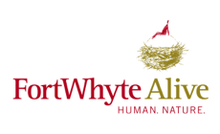FortWhyte Alive
FortWhyte Alive is an environmental, education and recreation centre at 1961 McCreary Rd. The large park and recreation facility is located in southwest Winnipeg along the migratory path of Canada geese.
 FortWhyte Alive! Logo | |
| Formation | 1983 |
|---|---|
| Type | Nature preserve |
| Headquarters | 1961 McCreary Rd. |
| Location | |
| Coordinates | 49.8202°N 97.2252°W |
Region | Winnipeg Metro Region |
Official language | English |
President and CEO | Liz Wilson |
Vice-President | Ian Barnett |
| Dr. Gordon Goldsborough Debbie Grenier Richard Enright Tammy Johnson Jody S. Langhan Shannon Magnusson Amy May Justice Michel A. Monnin Tanis Ostermann Sacha Paul Dr. Brian Postl Liz Prall, Chair Sprague Richardson Susan Schmidt Brian Thiessen, Past Chair Paul Vogt Liz Wilson, President & CEO | |
| Website | fortwhyte |
Formerly called | Fort Whyte Nature Centre |
Natural features
FortWhyte's 640 acres (260 ha) of prairie, lakes, forest and wetlands include a 70-acre (28 ha) bison prairie and related heritage exhibits;[1] more than 9 kilometres (5.6 miles) of interpretive nature trails; a family treehouse, floating boardwalks, and songbirds, deer and waterfowl in their natural habitat.
Activities and amenities
Year-round fishing is available or visitors can enjoy more contemplative pursuits such as canoeing, hiking or bird-watching.[2] Winter offers unique opportunities to enjoy ice fishing, snowshoeing, skating or tobogganing. FortWhyte's lakes, forest and marsh are well travelled, with over 100,000 visitors benefiting from many programs and exhibits annually.
The 6,700 sq ft (620 m2) Alloway Reception Centre offers a broad range of visitor services including The Nature Shop and Buffalo Stone Café.
The 10,000 sq ft (930 m2) Interpretive Centre features exhibits including the Aquarium of the Prairies (Manitoba's largest indoor aquarium), the Prairie Partners Room, the Touch Museum, the Climate Change Greenhouse and Prairie Soils dioramas among other exhibits relating to the environment and sustainable development. The secluded Siobhan Richardson Field Station and its three overnight cabins offer an ideal setting for longer-term studies, camp programs and workshops.
Situated on a reclaimed clay mine and cement factory, FortWhyte Alive is a dynamic example of sustainable development. FortWhyte is well respected for offering objective, balanced programs that recognize the inter-dependency between a healthy economy and a healthy environment, while on the leading edge of environmental education, outdoor recreation and social enterprise programming.
It is committed to promoting awareness and understanding of the natural world and actions that lead to sustainable living. This includes exploring the historical, current and future interaction between humans and the environment.
Education
It offers curriculum-based educational programs in both French and English to close to 30,000 school children each year; introducing students to the natural world and raising an awareness of their role in sustaining our planet. The FortWhyte Farms[3] initiative allows disadvantaged youth to engage in urban agriculture-based, social and vocational skills training[4] in FortWhyte's beautiful natural setting.
Public programs at FortWhyte Alive are designed to inspire visitors of all ages with an appreciation for the natural world, with seminars, hands-on workshops and recreational activities offered in every season.
More than 300 volunteers are involved in every aspect at Fort Whyte Alive, from policy development at the Board level to the delivery of more than 40 school and public programs.
Access
Despite being located within the Perimeter Highway, Fort Whyte Alive is currently beyond the service area of Winnipeg Transit.
Further reading
- Acorn, John; Smith, Alan; Koper, Nicola (2018). "Beaudry Provincial Park and FortWhyte Alive". Best Places to Bird in the Prairies. Greystone. ISBN 9781771643276
References
- "EcoTours". FortWhyte Alive. Retrieved 2019-10-23.
- "Manitoba's Pine To Prairie International Birding Trail" (PDF). Manitoba Conservation and Water Stewardship. May 7, 2013. Archived from the original (PDF) on February 13, 2019. Retrieved October 22, 2019.
- "Youth build self-esteem at Fort Whyte Farms". Metro News. August 8, 2013. Archived from the original on December 2, 2013.
- "Fort Whyte youth program gets $30K boost". CBC News Manitoba. July 13, 2010. Retrieved October 22, 2019.